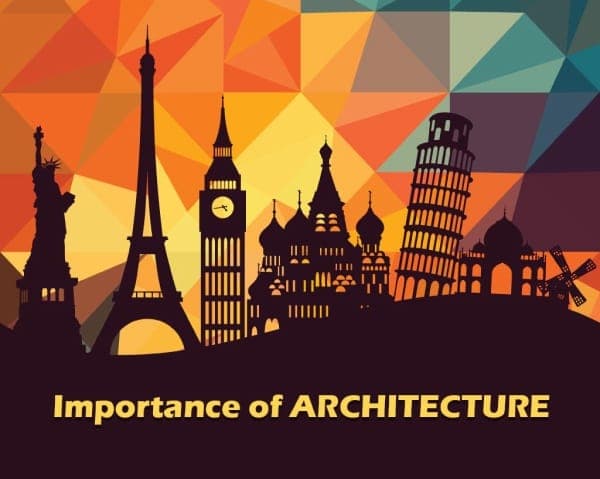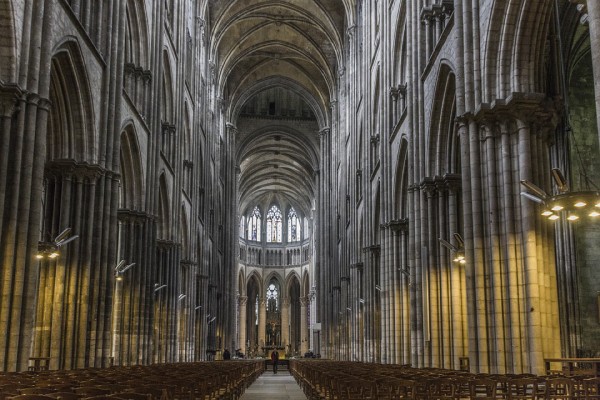
If you were asked to name and talk about some famous monumental buildings, it would not be too difficult a task; everyone has heard about the Taj Mahal in India, Burj Khalifa in Dubai, St. Paul’s Cathedral in London, the Notre Dame and the Eiffel Tower in Paris. If you were to talk about them, you would invariably end up talking about their architecture. In fact, you are probably surrounded by the efforts of architects while you are reading this.
However, most people fail to appreciate the importance of architecture and the incredible reach of this specific profession as well. Take a look below to understand how deeply architecture is entwined with our everyday lives.
The Reach of Architecture

The impact of architecture is much beyond the horizon of your imagination. Consider the ancient cultures for example.The first thing you learn while reading or studying about ancient cultures is, without a doubt, their architecture because it can be considered as the most explicit representation of any culture. For example – what is the first thing that comes to your mind when one mentions the Egyptian civilization? Of course, the majestic pyramids and if your GK is good, then also the Sphinx. Their pyramids, temples and, of course, the Sphinx, and other existing architectural structures speak volumes about the culture that existed centuries ago. It is easy to gain an idea of the lifestyle of the Egyptians of those times. The famed Indian monuments such as Khajuraho, Sun Temple at Konark amongst many others represent not only the culture that was prevalent in those times but also the religion and lifestyle of the Indians who lived during that particular period. It provides information regarding the wildlife and the natural habitat that existed in that period. The stones that were used to create the monuments are the rich sources of information regarding the geological composition of certain areas. Thus, you get to see the unique imprints and richly depicted culture followed during that time. The structures can also provide an idea of the land features from which the building materials were sourced.

Architecture is a social art that reaches all human beings at all levels of their existence everywhere and every day. It is the only discipline that encompasses four major fields of human endeavor: humanities, science, technology, and puts into practice the professional inputs drawn from them. Hence, architecture from a particular civilization is an evocative expression of the ethos of a conserved. It is thus heritage when done nicely and when it ruins, it becomes archaeology; that is reconstructing tells tale pictures of the past.Let’s take few steps back in history to The Middle Ages in Europe that saw the rise of Gothic architecture. This style of architecture was defined by the incredible towers and intricate stone masonry, especially for the churches and cathedrals of its time. The grand structures served as the perfect counterpoint to the strong and almost fearful religious reverence during what was rather an unstable period of history.
Move a little further into history and we reach Modernism in architecture or the Modern architecture which is invariably tied to the advent of the Industrial Revolution. After all, it was the scientific advancements made during this period that made it possible to mass produce glass, concrete and steel. The increasing order in cities and the materials led to the rise of residential steel buildings and other steel structures including high rise structures.
Architecture Makes a Strong Impact
Architecture is more than just a clever arrangement of bricks. As said by ‘Partha Sarathi Mishra and Aseema Das’ (Published in Building Material: Significance and Impact on Architecture) “It is not just the structural importance and constructional behavior, but also the visual impact along with the historical value of certain materials that form the essence of the built environment.” It is how architecture impacts the state of people’s mind. For example – when you visit a new place, have you ever felt like running away from that place as soon as possible or feel an instant connection with the place? It is because of the good or the bad vibrations that a place/architecture reflects.
According to ‘Inverse Group’ (Published in Inverse Architecture Magazine), “You are constantly surrounded by buildings and the spaces affect how you feel. Walking in a city surrounded by beautiful architecture gives us joy and fulfillment, while dark, old and obscure architecture take us to depression, cold attitude and dampening your mood.”
In short, architecture always reflects the cultural context and age in which it is produced. Architecture is a product of the culture for which it was designed. The architects have always tried to reflect a bigger picture of the relationship present between architecture and culture. This relationship has been studied for years. This happens irrespective of the type of structure built. After all, architecture is never produced in a vacuum.

Architects need to collaborate with various other professions including government officials and financiers. Of course, rules and regulations set by civic authorities, owners and building codes will also matter. As such, all of them end up having an impact on the final architecture of the building being created.As a result, architecture ends up defining how a culture sees itself and the world around it. Architecture doesn’t just create a pretty shelter. It ends up setting the context for lives. This is why Gothic architecture creates a sense of awe while the roof deck of a skyscraper makes you feel empowered.
Generally, architecture is only perceived on a smaller scale as a built form i.e. in the building. But, on a larger scale, well-planned cities like Gandhinagar and Chandigarh highlight the most significant experiments in urban planning and modern architecture. The design of these cities and the buildings in them speaks about its uniqueness and the uniformity maintained based on the hierarchy of movement throughout the city.
Architecture’s Importance
Architecture ends up connecting and impacting various aspects of everyday in ways that might not be immediately obvious. Here are some of them:
01. Economics
House construction is a basic activity in any economy as shelter is a must. In architecture, economics is not only about the cost of buildings, materials and labor. Instead, it is also about the economic flow that the resulting space can generate. It is not always about implementing aesthetic design. Instead, architects think about the traffic flow.
The architects consider aspects such as the location of the building, its end purpose, the type of traffic that will use it. Afterwards, they think about how they can help increase the traffic flow while reducing obstacles. They think of how they can help direct the traffic exactly where they want to go in the least amount of time. Architects also need to consider concepts such as the movement patterns of traffic, the safety issue and more. Even in residential steel buildings, architects consider the traffic flow although there is no end economic benefit to be gained.
In other words, you can get builders to give you a well-constructed structure. However, it is an architect who can help you in maximizing the potential profit that can be generated from your business, if you look at it from another angle.
02. Technology
Technology plays a major role in shaping the architecture the way it is now. As technology changes, the practice of architecture even changes. Earlier, without technology, the architecture’s value lied in the process of crafting and experiencing in a space. But nowadays, this value has evolved into visual aesthetics of space or we can say the visual architecture.
03. Quality of Life

Nowhere is the impact of an architect more clearly felt than in the quality of life aspect of a building. You may not think about it consciously but the space you live in actually has a direct and major impact on how you feel about your life.A builder will only provide you the space to live in. An architect will make it a space worth living in. They will bring in their creativity, some art and a bit of science to enhance your living space in ways you might not expect. He/she is the one to incorporate your lifestyle and future needs into plans while designing your home. An architect is the one who possesses, with due regard to aesthetic as well as practical considerations, adequate skills and knowledge to enable him/her to design and plan. His/her expertise lies in the art of designing buildings to meet his/her client’s not only the present but also the future needs.
This is not just about interior spaces but also the outside. If you think about it; the neighborhoods that feature contemporary architecture are nearly always perceived to be better places to live in. Even studies have shown that places with good architecture end up creating stronger communities.
04. Ease of Living
Good architecture reduces health problems of people at work. Stress can be reduced and mental health improved by ensuring that where possible, users of the space can have direct control over it.
05. Efficiency
Any space must offer efficiency to its users. A living space must consider the lifestyle of its occupants. For instance – a hospital space must consider the needs of the patients. A business space must consider the needs of the office goers. A residential space will be terribly inefficient if used as a hospital, school, theatres or vice versa. A space meant for a family of four will be too much for a single person. ‘Architecture that is built to heal’ is a documentary presented by Michael Murphy that envisions and creates community-centric structures with healing built into their core.
The needs of each kind of user are different and an architect must incorporate those needs to maximize the efficiency of the users. Of course, future needs are also considered in good architecture.
06. Safety and Security
The designs of the buildings must be safe and secured and here comes the role of architects and engineers. It requires a balance of design and construction elements in architecture when it comes to safety and security.Last Words:Even though architecture is rarely given a lot of thought in everyday life, the importance of architecture is by no means less. The importance of good contemporary architecture is evident in the fact that it does not need to be consciously thought of by the users. It is just there in the background helping you to live your life better than yesterday.
Also Read:
Importance of Hierarchy in Architecture
Know About the Transformation of Building in Architecture!
Importance of Building Orientation in Architecture!
Author Bio
Kazi Ubaid – Kazi Ubaid is a freelance writer, professional blogger, ghost writer and lifelong learner with an ongoing curiosity to learn new things. He uses that curiosity, combined with his experience as a freelance business owner to write about subjects valuable to small business.
































